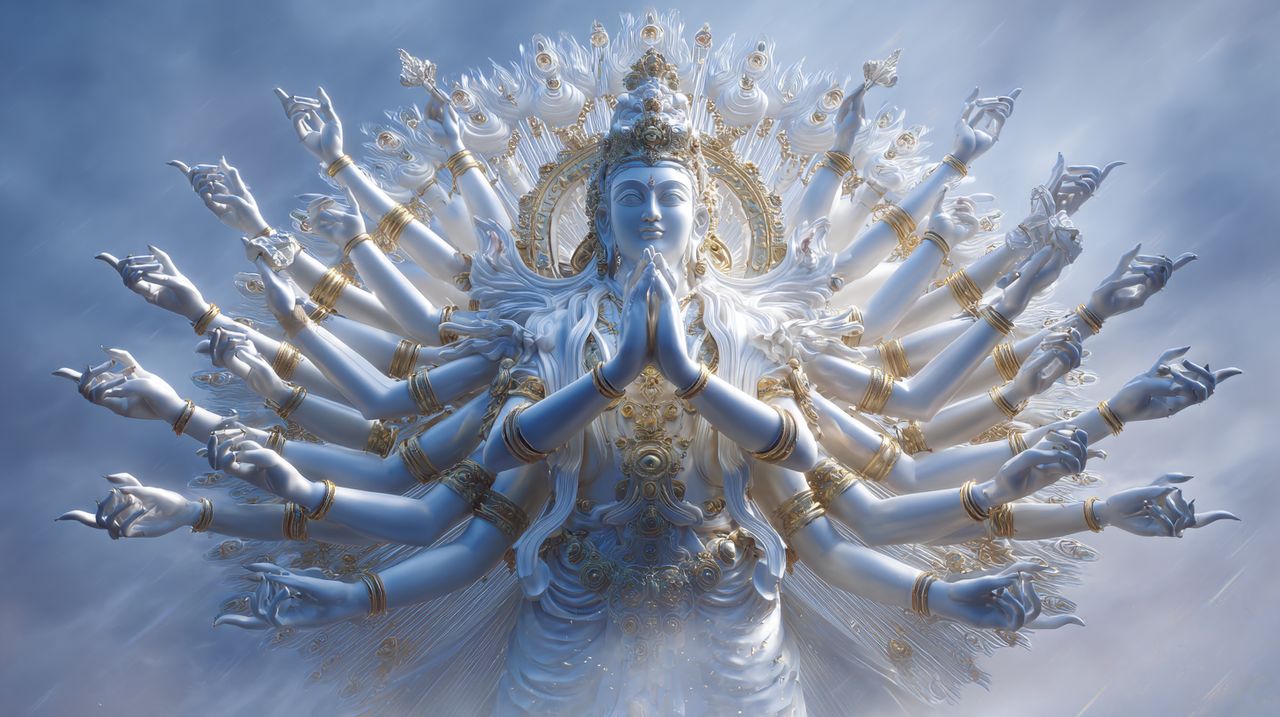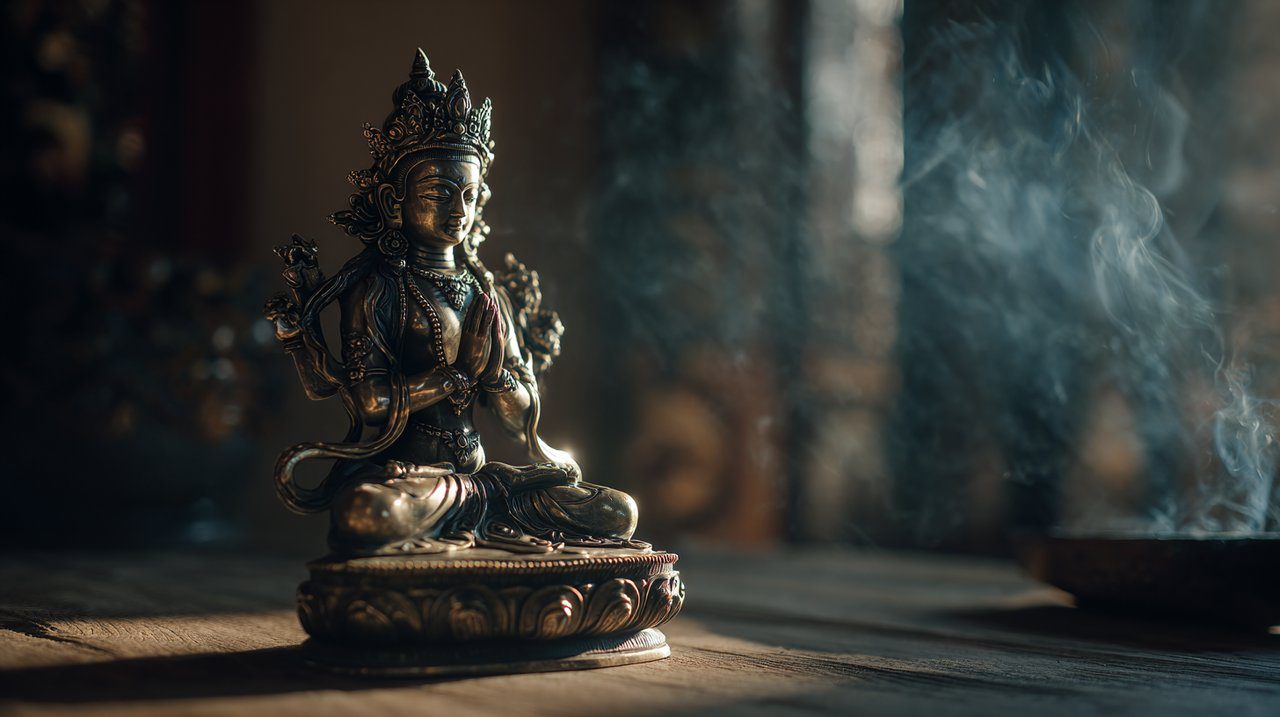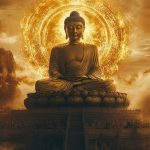Chenrezig: Unveiling the Many-Armed Buddha, His Compassion, and the Power of His Mantra
A Forest’s Embrace, A River’s Flow: The Gentle Heart of Chenrezig
Have you ever walked into a vast forest, feeling the quiet strength of ancient trees? Their countless branches reach out, not asking for anything, simply offering shelter and breath to all. This silent, expansive embrace, so much like the forest’s own giving, gently reminds us of Chenrezig, the Bodhisattva of Compassion.
He is like a river, flowing effortlessly, adapting to every landscape, yet always nourishing life along its path. In this gentle strength, we see the essence of true kindness.
Chenrezig: A Quiet Heart for All Beings

In the quiet spaces of Mahayana Buddhism, especially within Tibetan traditions, we encounter Chenrezig, known as Avalokiteshvara in Sanskrit. He is more than a figure; he is the living spirit of universal compassion, a gentle presence dedicated to easing suffering across the world.
His name itself, “The Lord Who Looks Down with unwavering eyes,” speaks to a constant, watchful care for all beings’ pain.
The Bodhisattva’s Quiet Promise
At the heart of Chenrezig’s existence lies his Bodhisattva Vow. It’s a sacred promise to postpone his own complete awakening until every living being finds freedom from suffering. This selfless pledge shows a deep dedication to the well-being of all.
It invites us to consider how we might gently expand our own circles of care, much like ripples spreading on a calm pond.
A Flowing Presence Across Lands
Chenrezig’s compassionate spirit flows across cultures and lands, much like a single stream finds many paths to the sea. In China, he is cherished as Guanyin, a gentle Bodhisattva of mercy.
In Japan, we know him as Kannon, sometimes shown with many heads and arms, hinting at his vast reach. These varied forms remind us that compassion’s quiet call resonates universally, its core message of boundless love always clear, no matter the name.
The Many Arms: A Tree’s Gentle Reach

When we see images of Chenrezig with many arms, perhaps even a thousand, it’s not a literal depiction. Instead, it’s like observing a mighty tree: its roots run deep, its branches spread wide, offering shelter and support without effort.
These many arms symbolize his boundless capacity to reach out, much like the tree’s branches, offering quiet assistance to countless beings at once. Each hand extends a unique way of helping, a skillful means, tailored for specific kinds of suffering. It’s a visual poem of active, gentle care.
Eyes in Every Hand: Seeing What is Needed
Imagine a thousand arms, and in each hand, an eye. This image suggests Chenrezig’s quiet wisdom, his ability to see and understand the suffering of all beings. These eyes are like the clear surface of a mountain lake, reflecting everything with unwavering clarity, allowing him to perceive precisely what is needed.
This blend of gentle compassion (the arms) and clear insight (the eyes) ensures his help is always fitting, always truly effective. It speaks to an empathy that both observes deeply and acts with care.
Different Forms, Same Gentle Spirit
Though the thousand-armed image is powerful, Chenrezig also appears with two or four arms, much like a cloud shifting its shape while still holding the rain. The two-armed form often holds a wish-fulfilling jewel, a quiet symbol of hopes fulfilled.
The four-armed form might hold a lotus, representing purity, and a mala for silent recitation. No matter the number, these arms always speak of his active, gentle compassion, his readiness to offer aid. These varied images simply make his vast, kind nature more approachable for us.
Om Mani Padme Hum: The Whisper of Inner Peace
The chenrezig mantra, Om Mani Padme Hum, is a gentle, resonant stream of sound flowing through Tibetan Buddhism. It is perhaps the most chanted of all. Like the soft murmur of a mountain stream, it purifies and calms the mind, inviting a quiet tranquility to settle within us.
Reciting this mantra chenrezig is a way to quietly invite Chenrezig’s compassion into our hearts, awakening the kindness already present. It is a simple bridge, connecting our own spirit to this boundless empathy.
The Six Gentle Whispers
Each syllable of Om Mani Padme Hum carries its own quiet wisdom, guiding us to clear away what clouds our spirit and embrace a clearer way of being:
- Om: A whisper of generosity, clearing away pride.
- Ma: A call to ethics, gently purifying jealousy.
- Ni: The patience of a still lake, calming desire.
- Pad: The quiet diligence of a growing seed, dissolving ignorance.
- Me: The focused calm of a mountain peak, releasing greed.
- Hum: The wisdom of the ancient earth, soothing hatred.
In these six sounds, we find a simple map to inner clarity, a quiet reflection of the Buddha’s teachings.
A Daily Rhythm for the Heart
Engaging with Om Mani Padme Hum can become a quiet daily rhythm, whether spoken softly or held silently within. Many find a gentle focus by using tibetan prayer wheels, where the inscribed mantra turns, like leaves carried on a breeze.
This practice helps to calm the mind, ease restless emotions, and deepen our sense of connection to all life. A steady presence with the mantra can soften the heart, expanding our natural capacity for empathy. It is a simple path to cultivating a quiet peace within.
Beyond Form: Living the Quiet Wisdom
Chenrezig’s wisdom is not confined to sacred spaces; it is found in how we live each day. It’s like observing the quiet strength of a mountain or the steadfast presence of an old tree, and recognizing that we, too, can cultivate such inner resilience and kindness.
His gentle teachings offer a way to move through our busy lives with an open heart, finding moments of peace and connection amidst the changing seasons of existence.
Statues: A Still Point of Reflection

A chenrezig statue is more than just a crafted form; it’s like a smooth river stone, inviting quiet reflection on compassion and wisdom. Placing such a statue in our home or quiet space can gently inspire mindfulness and a commitment to simple acts of kindness.
These forms, whether shaped from wood or metal, ask us to pause and consider the quiet qualities they hold. They are like silent companions, encouraging us to let kindness grow within us.
A Spring of Kindness in Our Days
In a world that often feels divided and moves too quickly, Chenrezig’s message of universal compassion becomes like a clear spring. We can cultivate this inner spring by truly listening, by offering quiet kindness to those we meet, and by extending forgiveness to ourselves and others.
Wearing quiet symbols like dzi beads or understanding the red string bracelet meaning can serve as gentle reminders of these intentions. Similarly, connecting with natural elements like healing crystals can foster inner harmony. Just as a spring continuously feeds a river, embracing Chenrezig’s essence allows us to become a gentle source of positive presence in the world.
Chenrezig, the quiet spirit of compassion, remains a constant presence, much like the enduring earth itself. From the silent giving of a forest to the inclusive flow of a river, we find reflections of his vast, gentle heart. His mantra, Om Mani Padme Hum, offers a resonant path to inner peace, and his many forms quietly inspire us to extend our own reach of kindness.
By cultivating this quiet wisdom, we can bring a gentle change to our own lives and contribute to a world where every being feels the soft embrace of universal care, much like the earth continually offers its bounty. We are simply invited to carry this spirit forward, becoming a quiet reflection of compassion in every moment.
💡 よくある質問
Chenrezig, also known as Avalokiteshvara in Sanskrit, is the Bodhisattva of Compassion in Mahayana Buddhism, particularly revered in Tibetan traditions. His name translates to 'The Lord Who Looks Down,' signifying his constant, watchful care for the suffering of all beings.
Chenrezig's Bodhisattva Vow is a sacred promise to postpone his own complete awakening until every living being is liberated from suffering. This selfless pledge highlights his profound dedication to the well-being of all sentient beings.
The numerous arms of Chenrezig symbolize his boundless capacity to reach out and offer assistance to countless beings simultaneously. The eyes often depicted in his palms represent his wisdom and insight, enabling him to perceive and understand the specific suffering of each being, ensuring his help is always fitting and effective.
Om Mani Padme Hum is the most widely chanted mantra in Tibetan Buddhism, associated with Chenrezig. Each syllable carries specific wisdom, designed to purify negative states of mind and cultivate virtues like generosity, ethics, patience, diligence, concentration, and wisdom. It is recited to invite Chenrezig's compassion and awaken inner kindness.
Chenrezig's spirit can be lived daily by cultivating universal compassion, offering kindness, practicing forgiveness, truly listening to others, and becoming a source of positive presence. His wisdom encourages moving through life with an open heart, finding peace and connection amidst daily challenges.








